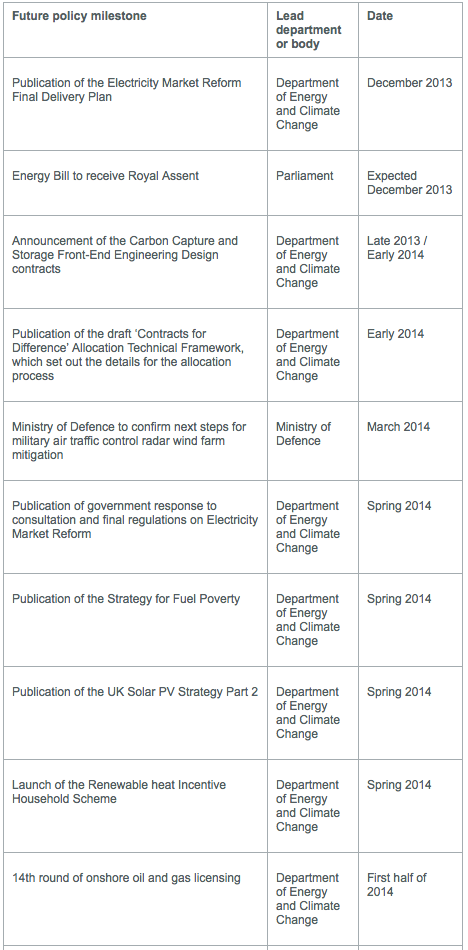National Infrastructure Plan 2013 – Energy aspects
13th December 2013
Overview of the National Infrastructure Plan 2013
On 4 December 2013 the Government published the latest version of the National Infrastructure Plan (the Plan), which was referred to by the Chancellor in his Autumn Statement the following day. The Plan identifies the Government’s Top 40 priority investments, which will be given their own dedicated ‘hot desk’ in Infrastructure UK and will be tracked by a new Major Infrastructure Tracking Unit.
The Plan:
- Sets out the Government’s overall vision for UK infrastructure and the need for investment (Chapter 1)
- Analyses the state of the UK infrastructure in 2013 (Chapter 2)
- For each sector (transport, energy, communications, waste, flood, water, intellectual capital), defines its strategic objectives, policy approach, key outcomes, upcoming policy milestones and the priority investments that are central to the achievement of those objectives (Chapter 3)
- Outlines the Government’s policy approach to local infrastructure (Chapter 4)
- Goes into detail on each of the key investments identified for each sector (Chapter 5)
- Defines where finance gaps remain and the action the government is taking to address them (Chapter 6)
Sets out ways the Government will make it easier to deliver infrastructure, including changes to the planning system and the judicial review process (Chapter 7).
Energy aspects of the Plan
The UK’s primary energy supply is currently met from the following main sources:
- natural gas (35 per cent)
- oil (32 per cent)
- coal (20 per cent)
- nuclear (7 per cent)
- biomass and waste (4 per cent)
- wind, hydro and solar photo-voltaic (1 per cent)
Electricity accounts for 19 per cent of energy consumption. The closure of old power stations means that the margins will reduce to between 2 and 5 per cent in 2015-16, increasing the possibility of a disruption to supply. Large scale investment in gas and low carbon technologies is therefore vital.
Figures in Chapter 2 show that energy projects have the largest pipeline of investment by value (over £215 billion, up from £176 billion in last year’s Plan). There are 275 energy projects and 40 programmes. Of these, 90 are in the scoping phase, 55 in planning, 81 have had consents approved, 54 are under construction and 35 are active.
Key policy milestones
The Plan has a handy table of key energy policy milestones
In terms of selecting energy projects, the Government seems content to leave it to the private sector to bring forward suggestions, rather than forcing particular energy projects (other than nuclear).
The following energy projects are in the Top 40 priority investments (which are numbered and grouped by sector rather than in order of priority):
*SI = strategic importance: project delivers a significant contribution towards a wider strategic objective or government target
CV = capital value: project is of significant size / capital value within a wider investment programme
There is further detail on all these projects in the Appendix to the Plan.
Chapter 6 of the Plan emphasises the Government’s measures to combat the ‘finance gap’ where there is not enough private finance for a project, and mentions the UK Guarantees Scheme and the Green Investment Bank as ways in which the Government is continuing to help finance energy and energy efficiency projects.
Changes to planning and judicial review
Chapter 7 of the Plan announces that the Government is launching an overarching review of the Nationally Significant Infrastructure Project regime and will be setting up a specialist planning court to speed up the handling of cases, and will also introduce legislation to ensure that minor procedural claims are dealt with proportionally and allow appeals to ‘leapfrog’ directly to the Supreme Court in a wider range of circumstances. The Ministry of Justice will report further in January 2014.
In terms of local planning, the Government will consult on introducing a statutory requirement to put a Local Plan in place and will legislate so that where a planning authority has failed to discharge a condition on time it will be treated as approved. It will also consult on using legislative measures to strengthen the requirement for planning authorities to justify conditions that must be discharged before any work can start.
Comment
Energy and transport seem to be the two key sectors which the Government expects will drive the UK’s infrastructure growth. With a large pipeline of projects and Government help to close the funding gap, energy sets to remain crucial to the UK economy.


